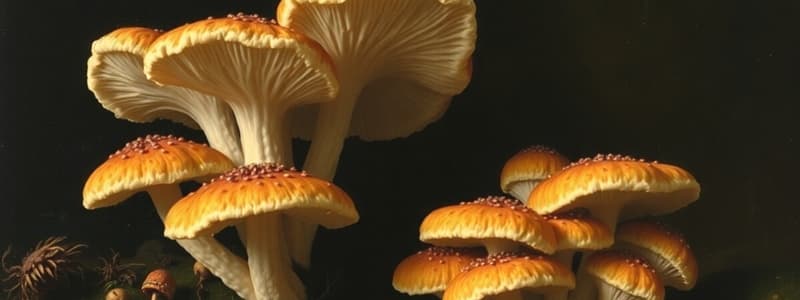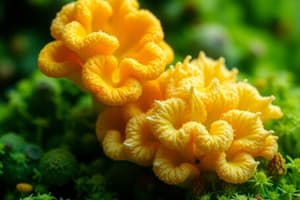Podcast
Questions and Answers
Which of the following is a key advantage of employing fungi in biotechnology?
Which of the following is a key advantage of employing fungi in biotechnology?
- Limited metabolic capabilities
- Poor heavy metal biosorption
- Versatile metabolism (correct)
- Inability to decompose organic waste
What environmental pollutants can white-rot fungi degrade?
What environmental pollutants can white-rot fungi degrade?
- Polycyclic aromatic hydrocarbons (PAHs) (correct)
- Table salt
- Nitrogen gas
- Simple sugars
Fungi are effective in decomposing which type of waste materials?
Fungi are effective in decomposing which type of waste materials?
- Organic waste materials (correct)
- Nuclear waste
- Precious metals
- Inorganic minerals
What is produced when fungi break down lignocellulosic biomass?
What is produced when fungi break down lignocellulosic biomass?
Which relationship do mycorrhizal fungi form with plants?
Which relationship do mycorrhizal fungi form with plants?
What main benefit do endophytic fungi provide to plants?
What main benefit do endophytic fungi provide to plants?
What type of agents can fungi produce?
What type of agents can fungi produce?
Cyclosporine and taxol, derived from fungi, are examples of what?
Cyclosporine and taxol, derived from fungi, are examples of what?
What is one type of biofuel fungi can be used to produce?
What is one type of biofuel fungi can be used to produce?
What process can fungi enhance to increase biogas yield?
What process can fungi enhance to increase biogas yield?
Fungi are a source of industrial enzymes used in which industry?
Fungi are a source of industrial enzymes used in which industry?
What food product is produced using fungi in fermentation processes?
What food product is produced using fungi in fermentation processes?
The use of fungi in bioremediation provides what type of solutions?
The use of fungi in bioremediation provides what type of solutions?
Fungi are amenable to genetic modification for optimizing what?
Fungi are amenable to genetic modification for optimizing what?
Many fungi can be cultivated on what type of substrates, making them economically viable?
Many fungi can be cultivated on what type of substrates, making them economically viable?
What do cyanobacteria convert solar energy into?
What do cyanobacteria convert solar energy into?
Cyanobacteria can fix atmospheric CO2, which aids in what process?
Cyanobacteria can fix atmospheric CO2, which aids in what process?
Compared to higher organisms, cyanobacteria are easier to do what to?
Compared to higher organisms, cyanobacteria are easier to do what to?
Cyanobacteria can produce biofuels such as hydrogen and?
Cyanobacteria can produce biofuels such as hydrogen and?
Cyanobacteria are effective in treating wastewater by removing what?
Cyanobacteria are effective in treating wastewater by removing what?
Cyanobacteria fix atmospheric nitrogen, enriching what?
Cyanobacteria fix atmospheric nitrogen, enriching what?
Cyanobacteria can produce biodegradable plastics known as what?
Cyanobacteria can produce biodegradable plastics known as what?
Cyanobacteria are rich in proteins, essential amino acids, and?
Cyanobacteria are rich in proteins, essential amino acids, and?
Some cyanobacteria can produce hydrogen gas through what process?
Some cyanobacteria can produce hydrogen gas through what process?
Cyanobacteria can be cultivated using what type of land, reducing competition with food crops?
Cyanobacteria can be cultivated using what type of land, reducing competition with food crops?
What allows bacteria to be employed in biotechnology?
What allows bacteria to be employed in biotechnology?
What kind of genomes do bacteria have?
What kind of genomes do bacteria have?
Bacteria can grow on what, reducing production costs?
Bacteria can grow on what, reducing production costs?
What are bacteria widely used as, for producing recombinant proteins?
What are bacteria widely used as, for producing recombinant proteins?
Bacteria produce enzymes like amylases, proteases, and?
Bacteria produce enzymes like amylases, proteases, and?
What can bacteria break down to help in bioremediation?
What can bacteria break down to help in bioremediation?
Bacteria can ferment sugars to produce biofuels such as ethanol and?
Bacteria can ferment sugars to produce biofuels such as ethanol and?
What do bacteria synthesize that are environmentally friendly alternatives to petroleum-based plastics?
What do bacteria synthesize that are environmentally friendly alternatives to petroleum-based plastics?
Bacteria are used to produce what, including recombinant vaccines?
Bacteria are used to produce what, including recombinant vaccines?
Bacteria like Rhizobium do what, enriching soil fertility?
Bacteria like Rhizobium do what, enriching soil fertility?
Many Archaea are what, thriving in environments with extreme conditions?
Many Archaea are what, thriving in environments with extreme conditions?
Thermophilic Archaea can withstand which extreme condition?
Thermophilic Archaea can withstand which extreme condition?
Halophilic Archaea thrive in which type of environment?
Halophilic Archaea thrive in which type of environment?
What do Archaea produce that remain stable at high temperatures?
What do Archaea produce that remain stable at high temperatures?
Methanogenic Archaea play a key role in what process?
Methanogenic Archaea play a key role in what process?
Some Archaea can do what to heavy metals, making them useful for cleaning up contaminated environments?
Some Archaea can do what to heavy metals, making them useful for cleaning up contaminated environments?
Flashcards
Fungal Enzyme Production
Fungal Enzyme Production
Fungi's capacity to produce diverse extracellular enzymes (cellulases, ligninases, proteases) to break down complex compounds.
Fungal Secondary Metabolites
Fungal Secondary Metabolites
Fungi's ability to produce diverse secondary metabolites useful in pharmaceuticals such as antibiotics and anticancer agents.
Fungal Pollutant Degradation
Fungal Pollutant Degradation
Fungi's ability, especially white-rot fungi, to break down persistent pollutants like PAHs, pesticides, and dyes.
Heavy Metal Biosorption by Fungi
Heavy Metal Biosorption by Fungi
Signup and view all the flashcards
Fungi for Organic Waste Management
Fungi for Organic Waste Management
Signup and view all the flashcards
Fungal Lignocellulosic Conversion
Fungal Lignocellulosic Conversion
Signup and view all the flashcards
Mycorrhizal Associations
Mycorrhizal Associations
Signup and view all the flashcards
Endophytic Fungi
Endophytic Fungi
Signup and view all the flashcards
Fungi as Antimicrobial Agents
Fungi as Antimicrobial Agents
Signup and view all the flashcards
Fungi for Biofuel Production
Fungi for Biofuel Production
Signup and view all the flashcards
Fungi for Biogas Production
Fungi for Biogas Production
Signup and view all the flashcards
Fungi in Industrial Enzyme Production
Fungi in Industrial Enzyme Production
Signup and view all the flashcards
Fungi in Fermentation Processes
Fungi in Fermentation Processes
Signup and view all the flashcards
Fungi as Eco-Friendly Solutions
Fungi as Eco-Friendly Solutions
Signup and view all the flashcards
Genetic Manipulation of Fungi
Genetic Manipulation of Fungi
Signup and view all the flashcards
Fungal Heterologous Protein Production
Fungal Heterologous Protein Production
Signup and view all the flashcards
Low-Cost Cultivation of Fungi
Low-Cost Cultivation of Fungi
Signup and view all the flashcards
Fungi for Waste Utilization
Fungi for Waste Utilization
Signup and view all the flashcards
Cyanobacteria Photosynthetic Yield
Cyanobacteria Photosynthetic Yield
Signup and view all the flashcards
Cyanobacteria CO2 Sequestration
Cyanobacteria CO2 Sequestration
Signup and view all the flashcards
Cyanobacteria Biofuel Production
Cyanobacteria Biofuel Production
Signup and view all the flashcards
Cyanobacteria Biochemicals
Cyanobacteria Biochemicals
Signup and view all the flashcards
Cyanobacteria Bioremediation
Cyanobacteria Bioremediation
Signup and view all the flashcards
Cyanobacteria Wastewater Treatment
Cyanobacteria Wastewater Treatment
Signup and view all the flashcards
Cyanobacteria Biofertilizers
Cyanobacteria Biofertilizers
Signup and view all the flashcards
Cyanobacteria Soil Health
Cyanobacteria Soil Health
Signup and view all the flashcards
Rapid Bacterial Reproduction
Rapid Bacterial Reproduction
Signup and view all the flashcards
Bacteria as Well-Studied Models
Bacteria as Well-Studied Models
Signup and view all the flashcards
Low Nutrient Requirements
Low Nutrient Requirements
Signup and view all the flashcards
Bacterial Scalability
Bacterial Scalability
Signup and view all the flashcards
Bacterial Recombinant Protein Production
Bacterial Recombinant Protein Production
Signup and view all the flashcards
Bacterial Industrial Enzyme Production
Bacterial Industrial Enzyme Production
Signup and view all the flashcards
Thermostable Bacterial Enzymes
Thermostable Bacterial Enzymes
Signup and view all the flashcards
Bacterial Pollutant Degradation
Bacterial Pollutant Degradation
Signup and view all the flashcards
Bacterial Wastewater Treatment
Bacterial Wastewater Treatment
Signup and view all the flashcards
Thermophilic Archaea
Thermophilic Archaea
Signup and view all the flashcards
Methanogens
Methanogens
Signup and view all the flashcards
Archaea Nitrogen Fixation
Archaea Nitrogen Fixation
Signup and view all the flashcards
Study Notes
Advantages of Fungi in Biotechnology
- Fungi possess diverse metabolic capabilities, environmental benefits, and cost-effectiveness that make them valuable in biotechnology.
Versatile Metabolism
- Fungi produce extracellular enzymes like cellulases, ligninases, and proteases which degrade complex compounds.
- The enzymes that fungi produce make them useful in various biotechnological applications.
- Fungi produce secondary metabolites, that have pharmaceutical applications, like antibiotics, antifungals, and anticancer agents.
Bioremediation Capabilities
- White-rot fungi degrade persistent pollutants like polycyclic aromatic hydrocarbons (PAHs), pesticides, and dyes.
- Fungi can absorb and accumulate heavy metals from contaminated environments, which aids in detoxification.
Efficient Decomposition
- Fungi can decompose organic waste materials, including agricultural residues and municipal solid waste, into compost and biofertilizers.
- Fungi break down lignocellulosic materials into fermentable sugars used for biofuel production.
Symbiotic Relationships
- Mycorrhizal fungi form symbiotic relationships with plant roots, enhancing nutrient uptake (particularly phosphorus) and improving plant growth and soil health.
- Endophytic fungi live inside plant tissues and promote plant growth while increasing pathogen and environmental stress resistance.
Production of Bioactive Compounds
- Fungi produce antimicrobial compounds, that can be used to develop new antibiotics and antifungal agents.
- Cyclosporine (immunosuppressant) and taxol (anticancer drug) are derived from fungi.
Bioenergy Production
- Fungi are used to produce biofuels like bioethanol and biodiesel.
- Certain fungi ferment sugars into ethanol, while others produce lipids for biodiesel.
- Fungi enhance the breakdown of organic matter in anaerobic digestion, increasing biogas yield.
Industrial Applications
- Fungi produce various industrial enzymes used in food processing, textile manufacturing, and biofuel production.
- Fungi are used to produce food products like bread, cheese, and alcoholic beverages through fermentation.
Environmental Sustainability
- Fungi are used in bioremediation and waste management, providing sustainable and eco-friendly solutions to environmental problems.
Genetic and Metabolic Engineering
- Fungi are amenable to genetic modification, which allows optimization of metabolic pathways, to enhance production of desired compounds.
- Fungi can be engineered to produce heterologous proteins, including therapeutic proteins and industrial enzymes.
Cost-Effectiveness
- Many fungi can be cultivated on low-cost substrates, making them economically viable for industrial applications.
- Fungi can grow on various waste materials, which turns waste into valuable products while reducing raw material costs.
Advantages of Cyanobacteria
- Cyanobacteria are also known as blue-green algae
- Cyanobacteria possess unique characteristics and versatile applications that make them suitable material for use in biotechnology.
Photosynthetic Efficiency
- Cyanobacteria efficiently convert solar energy into biomass, making them ideal for biofuel production and carbon sequestration.
- Cyanobacteria contribute to global oxygen production and can be harnessed in bioregenerative life support systems.
Carbon Fixation
- Cyanobacteria can fix atmospheric CO2, reducing greenhouse gas emissions and aiding in climate change mitigation.
- Cyanobacteria can be used in carbon-neutral or carbon-negative biotechnological processes.
Genetic Manipulation
- Cyanobacteria have relatively simple genomes, making them easier to genetically manipulate compared to higher organisms.
- Cyanobacteria serve as model organisms for studying photosynthesis and nitrogen fixation.
Production of Valuable Compounds
- Through metabolic engineering, cyanobacteria produce biofuels like hydrogen, ethanol, and biodiesel.
- Cyanobacteria synthesize a variety of biochemicals, like pigments, vitamins, and antioxidants.
- Cyanobacteria produce bioactive compounds with pharmaceutical applications, such as antibiotics and anticancer agents.
Environmental Applications
- Cyanobacteria clean up contaminated environments by absorbing heavy metals and degrading pollutants.
- They are effective in treating wastewater by removing nutrients like nitrogen and phosphorus.
Sustainable Agriculture
- Cyanobacteria enrich soil fertility and reduce the need for chemical fertilizers, as they can fix atmospheric nitrogen
- They improve soil structure and health, promoting sustainable agricultural practices.
Biodegradable Plastics
- Cyanobacteria produce biodegradable polyhydroxyalkanoates (PHAs), which is alternative to conventional plastics.
Nutraceuticals and Food Supplements
- Cyanobacteria, which contain proteins, essential amino acids, and omega-3 fatty acids, are valuable as food supplements.
- Cyanobacteria are used in the production of functional foods and nutraceuticals.
Renewable Energy
- Some cyanobacteria produce hydrogen gas through photosynthesis and offer as a renewable energy source.
- Cyanobacteria can be engineered to produce solar biofuels, providing a sustainable energy alternative.
Cost-Effectiveness
- Cyanobacteria can be cultivated using non-arable land and saline water, reducing competition with food crops and lowering production costs.
- Cyanobacteria can be grown in large-scale bioreactors or open ponds, making them scalable for industrial applications.
Biosensors
- Cyanobacteria can be engineered to function as biosensors for detecting environmental pollutants and changes in ecosystem health.
Advantages of Bacteria in Biotechnology
- Bacteria possess versatility, rapid growth, and ease of genetic manipulation.
- Bacteria have crucial roles in industrial, medical, and environmental applications.
Rapid Growth and High Yield
- Bacteria reproduce quickly, often doubling in number every 20-30 minutes under optimal conditions, which, in turn allows for rapid production of biomolecules.
- Fast growth enables large-scale production of proteins, enzymes, and other metabolites in a short time.
Ease of Genetic Manipulation
- Bacteria have relatively simple genomes making them easier to genetically engineer.
- Bacteria like Escherichia coli (E. coli) and Bacillus subtilis are well-characterized model organisms with established genetic tools and techniques.
- Advanced gene-editing tools like CRISPR-Cas9 can be easily applied to bacteria for precise genetic modifications.
Cost-Effective Cultivation
- Bacteria can grow on inexpensive media, reducing production costs.
- Bacteria can be cultivated in large fermenters or bioreactors bringing scalability for industrial-scale production.
Production of Recombinant Proteins
- Bacteria produce recombinant proteins, such as insulin, growth hormones, and vaccines.
- Some bacteria, like E. coli, can be engineered to perform post-translational modifications, enhancing the functionality of recombinant proteins.
Enzyme Production
- Bacteria produce industrial enzymes like amylases, proteases, lipases, and cellulases, which are used in industries such as food processing, detergents, and biofuels.
- Thermophilic bacteria produce thermostable enzymes that are useful in industrial processes.
Bioremediation
- Bacteria degrade environmental pollutants, like oil spills, pesticides, and heavy metals.
- Bacteria are used in wastewater treatment plants to remove organic matter and nutrients like nitrogen and phosphorus.
Biofuel Production
- Bacteria like Clostridium species can ferment sugars to produce biofuels such as ethanol and butanol.
- Some bacteria produce hydrogen gas through fermentation or photosynthesis as a renewable energy source.
Production of Bioplastics
- Bacteria synthesize biodegradable polyhydroxyalkanoates (PHAs), which is an environmentally friendly alternatives to petroleum-based plastics.
Medical and Pharmaceutical Applications
- Bacteria like Streptomyces produce antibiotics such as streptomycin and tetracycline.
- Bacteria produce vaccines, including recombinant subunit vaccines and live attenuated vaccines.
- Beneficial bacteria like Lactobacillus and Bifidobacterium are used as probiotics to promote gut health.
Agriculture and Biofertilizers
- Bacteria like Rhizobium and Azotobacter fix atmospheric nitrogen, enriching soil fertility and reducing the need for chemical fertilizers.
- Some bacteria produce plant growth hormones and protect plants from pathogens, which enhances crop yields.
Synthetic Biology
- Bacteria can be engineered to produce novel compounds, like biofuels, pharmaceuticals, and fine chemicals, by redesigning metabolic pathways.
- Engineered bacteria can be used as biosensors to detect environmental pollutants, pathogens, or specific molecules.
Environmental Sustainability
- Bacteria can be used in carbon-neutral or carbon-negative processes, such as biofuel production and carbon sequestration.
- Bacteria can utilize renewable resources like agricultural waste or CO2 as feedstocks, reducing reliance on fossil fuels.
Low Ethical Concerns
- Using bacteria avoids ethical concerns associated with animal or human cell-based systems, making them more acceptable for research and production.
Advantages of Archaea in Biotechnology
- Archaea can thrive in extreme environments.
- They have unique biochemical properties
Extremophiles with Unique Adaptations
- Many Archaea are extremophiles, thriving in environments with high temperatures, acidity, salinity, or pressure, which makes them valuable for industrial processes.
- Thermophilic Archaea (e.g., Pyrococcus, Thermococcus) can withstand high temperatures, which makes them used for high-temperature industrial processes like PCR (using thermostable DNA polymerases such as Taq polymerase).
- Halophilic archaea thrive in salty environments and are used to study salt tolerance and produce compatible solutes.
- Acidophiles and alkaliphiles are useful for bioremediation and mining applications as they survive in extremely acidic or alkaline conditions.
Unique Enzymes (Extremozymes)
- Archaea produce thermostable enzymes for industrial processes like biofuel production, food processing, and waste treatment.
- Halophilic Archaea produce salt-tolerant enzymes that function in high-salt conditions for industrial processes requiring saline environments.
- Enzymes from acidophilic or alkaliphilic Archaea are valuable for processes requiring extreme pH conditions.
Biogas Production
- Methanogenic Archaea (e.g., Methanobacterium, Methanosarcina) play a role in anaerobic digestion, as they can convert organic waste into methane (biogas), a renewable energy source.
- Methanogens are used in wastewater treatment plants to break down organic matter and produce biogas.
Bioremediation
- Some Archaea tolerate and sequester heavy metals, which makes them useful for cleaning up contaminated environments.
- Certain Archaea can degrade hydrocarbons for the cleanup of oil spills and other petroleum-based pollutants.
Sustainable Agriculture
- Some Archaea contribute to nitrogen fixation, enriching soil fertility and reducing the need for chemical fertilizers.
- Archaea produce compounds that promote plant growth and protect crops from pathogens.
Unique Metabolic Pathways
- Certain Archaea produce hydrogen gas through unique metabolic pathways, offering a renewable energy source.
- Some Archaea use alternative carbon fixation pathways, such as the 3-hydroxypropionate/4-hydroxybutyrate cycle, which can be harnessed for CO2 sequestration.
Medical and Pharmaceutical Applications
- Some Archaea produce unique lipids and compounds with potential antiviral properties.
- Archaeal proteins are often more stable under extreme conditions for developing therapeutic proteins and vaccines.
Synthetic Biology and Metabolic Engineering
-
Archaea possess unique metabolic pathways that can be engineered to produce valuable compounds, like biofuels, pharmaceuticals, and fine chemicals.
-
Extremophilic Archaea serve as model organisms for studying life under extreme conditions.
Environmental Sustainability
- Archaea can be used in carbon-neutral or carbon-negative processes, such as biogas production and CO2 sequestration.
- They can utilize renewable resources like agricultural waste or CO2 as feedstocks, reducing reliance on fossil fuels.
Low Competition with Food Crops
- Archaea can be cultivated in extreme environments, such as deserts or saline lakes, this subsequently reduces competition with food crops for arable land and freshwater.
Advantages of Algae in Biotechnology
- Algae is a valuable resource in biotechnology due to unique properties and versatility.
Photosynthetic Efficiency
- Algae convert sunlight into energy through photosynthesis, which is a sustainable sources of biofuels, chemicals, and other products.
- They can capture and utilize carbon dioxide (CO2), contributing to carbon sequestration and reducing greenhouse gas emissions.
Diverse Biochemical Composition
- Algae produce lipids for biodiesel production.
- They provide proteins for food supplements or animal feed.
- They create carbohydrates, to be used for bioethanol production.
- Algae produce pigments (e.g., carotenoids, phycobiliproteins) for usage in food, cosmetics, and pharmaceuticals.
- They have antioxidents and bioactive compounds for nutraceuticals and medical applications.
Genetic Manipulation and Synthetic Biology
- Algae are amenable to genetic engineering, thus allowing scientists to enhance productivity or modify metabolic pathways to produce specific compounds.
- Synthetic biology tools can be used to design algae strains for tailored applications (high lipid production or pharmaceutical protein synthesis).
Applications in Multiple Industries
- Algae-derived biodiesel, bioethanol, and biogas are renewable energy sources.
- Algae, being rich in proteins, vitamins, and minerals, are in turn a nutritious food source for humans and animals.
- Algae produce bioactive compounds with potential therapeutic applications, such as anti-inflammatory, antiviral, and anticancer agents.
- Algal extracts have moisturizing, anti-aging, and UV-protective properties for cosmetics products.
- Algae produce bioplastics, which reduces reliance on petroleum-based plastics.
Carbon Neutrality
- Algae absorb CO2 during photosynthesis, making their cultivation and use in biofuel production carbon-neutral or even carbon-negative.
Low Input Requirements
- Algae require minimal inputs like fertilizers and pesticides compared to traditional crops, reducing environmental impact.
Potential for Large-Scale Production
- Algae can be cultivated on a large scale in controlled environments which make them suited for use in industrial applications.
Studying That Suits You
Use AI to generate personalized quizzes and flashcards to suit your learning preferences.





